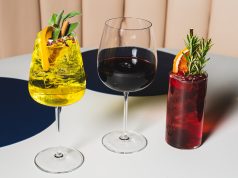
As a kid, I was aware that a pink wine called white zinfandel existed, but my dad considered it crap. That memory lasted well into my adulthood: Don’t buy pink wine because it’s garbage. Fast forward to five years ago or so, and you’ll find entire rows of rosé in liquor stores and a deep craving for it by wine enthusiasts as we approach summer. I had some questions about all of this, so I sought out answers over a rosé tasting with the two local wineries bottling rosé: Bookcliff Vineyards and Settembre Cellars.
Blake and Tracy Eliasson of Settembre Cellars invited Ulla Merz of Bookcliff Vineyards and me to their beautiful tasting room in North Boulder in the Boulder Wine Studios. Merz started by telling me that rosé wines are inspired by Italy and France where you pick grapes three to four weeks earlier than you would for red wine. The three winemakers then explained to me the three different methods for making rosé. One, which Settembre Cellars employs, is to leave the skins on briefly during the pressing; another where one mixes red and white grapes together; and the third is the technique of choice for Bookcliff: bleed off some juice to make both a deeper red (more skins in the wine than usual) and a rosé.
What once was a by-product of wine production has now become a craft, and wine makers worldwide are honing their skills to bottle pink wines fast enough to meet thirsty consumer demands. But, consumers can’t necessarily know what to expect from each bottle as there’s no sweetness rating like you find with Rieslings. Merz of Bookcliff suggests you ask your local wine seller for help selecting a bottle because there is a chance you’ll end up disappointed.
Will Frischkorn of Cured in Boulder says they’re selling a lineup of 27 rosés this season. There are a few they’ll sell all year and a number of which they could only get a case or two that will come and go quickly.
“It’s been amazing to watch rosé develop into a category with such a following, and rightly so,” Frischkorn says. “The past five years has seen so many producers look at rosé with real focus, not just as a little something on the side, and the results show in the bottle.”
A few of Frischkorn’s favorites at the moment:
The Premiere from St. Andre de Figuiere: From a respected provencal house, the Premiere de Figuiere is a blend of Mourvedre, Cinsault and Grenache, and it could be the quintessential provencal rosé. Incredibly crisp, light citrus and melon fruit on a mineral backbone and a finish that just screams for a bite of cheese.
Arnot Roberts Rosé: One of the favorite California producers once again exceeds expectations delivering a rosé this year that begs for food. Made using a small parcel of Touriga Nacionall, a grape of Portuguese origin rarely found elsewhere, this incredibly lean, structured and fresh rosé pairs well with roast chicken.
The Essential Rosé: Crisp, but friendly as can be, it’s a bottle that seems to quickly disappear whenever its cork is pulled. It pairs with a huge variety of cheeses but has a soft spot for Garrotxa, a Catalan goat’s milk cheese.
If you’re really interested in tasting rosé, save the date for the first-ever Drink Pink Vino International Rosé Wine Festival at the Omni Interlocken Resort in Broomfield on June 11. Wine enthusiasts can sample more than sixty new releases, which sounds like a great way to start the summer rosé drinking season.














